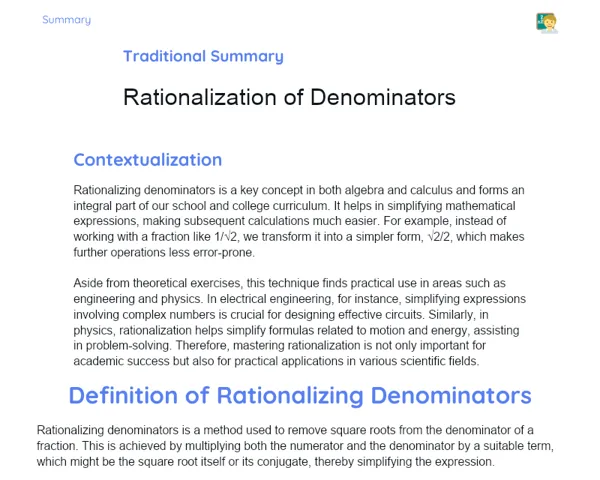Goals
1. Understand the concept of arithmetic progression (AP).
2. Learn how to calculate the sum of the terms of an AP.
3. Solve practical problems involving the sum of an AP, like the classic example of 1+2+3+4+5.
Contextualization
Arithmetic progression is a sequence of numbers where the difference between consecutive terms remains constant. This concept is widely relevant across different fields and in the job market. For instance, engineers and architects utilize arithmetic progressions to determine measurements and materials required for construction projects. Similarly, in finance, it's often employed for calculating simple interest and future investments. A well-known example is the formula that Carl Friedrich Gauss discovered as a child, where he ingeniously summed the numbers from 1 to 100 by pairing the extremes of the sequence (e.g., 1+100, 2+99), making the calculation much easier.
Subject Relevance
To Remember!
Definition of Arithmetic Progression (AP)
An Arithmetic Progression (AP) is a sequence of numbers where the difference between two consecutive terms is consistent. This difference, termed the common difference, can be positive, negative, or even zero. AP is a vital mathematical concept used in various fields, including engineering and finance.
-
The common difference is the fixed difference between consecutive terms.
-
An AP can either increase, decrease, or remain constant, based on its common difference.
-
The formula for the n-th term of an AP is: an = a1 + (n-1) * r, where an is the n-th term, a1 is the first term, and r is the common difference.
Formula for the Sum of the Terms of an AP
The formula for finding the sum of the terms in an Arithmetic Progression is essential for addressing problems involving numbered sequences. The general formula is: S = n/2 * (a1 + an), where S represents the sum of n terms, a1 is the first term, and an is the n-th term.
-
This formula simplifies the process of summing a series of numbers in an AP.
-
It's applicable in various scenarios, including financial calculations and engineering challenges.
-
This method aids in computing the sum of large sequences without needing to tally each term individually.
Practical Applications of AP in the Job Market
The understanding and application of arithmetic progressions prove invaluable in many professions. Fields like engineering, architecture, economics, and IT frequently deploy AP to tackle real-world problems, such as material calculations and developing financial forecasts.
-
Engineering: Employing it to determine distances, materials, and construction designs.
-
Economics: Used in calculating simple interest, financial forecasts, and data assessments.
-
Information Technology: Important in creating sorting algorithms and analysing data.
Practical Applications
-
Civil Engineering: Assessing materials required for staircases and ramps, where each step can follow an arithmetic progression.
-
Economics: For simple interest dealings and projecting investments, where values align as an arithmetic progression over time.
-
Business Administration: Assisting in financial and budgeting processes, where expenses or revenues can be anticipated as arithmetic progressions.
Key Terms
-
Arithmetic Progression (AP): A sequence where the difference between consecutive numbers is uniform.
-
Common Difference: The consistent difference between consecutive terms of an AP.
-
Sum of the AP Formula: S = n/2 * (a1 + an), used for calculating the sum of terms in an AP.
-
Carl Friedrich Gauss: The mathematician noted for discovering a quick method to sum sequential numbers, enhancing the understanding of arithmetic progressions.
Questions for Reflections
-
How can mastering the sum of an arithmetic progression assist you in your future profession?
-
Are there other fields, apart from engineering and economics, that could benefit from arithmetic progressions?
-
In what ways could the skill to compute the sum of an AP help in resolving complex issues in daily life?
Building an Arithmetic Progression Staircase
In this mini-challenge, you will apply your understanding of the sum of arithmetic progressions by constructing a staircase model using blocks or LEGO pieces. Each step of the staircase should adhere to an arithmetic progression, where the height of every step increases at a constant rate.
Instructions
-
Form groups of 3 to 4 participants.
-
Use blocks or LEGO pieces to assemble the staircase.
-
Establish the initial height of the first step and the constant increase (common difference).
-
Calculate the total height of the staircase if it comprises 10 steps, applying the sum formula of the AP.
-
Build the staircase based on your calculations.
-
Present your staircase design to the classroom, explaining the calculations used to determine the overall height based on the sum formula of the AP.



